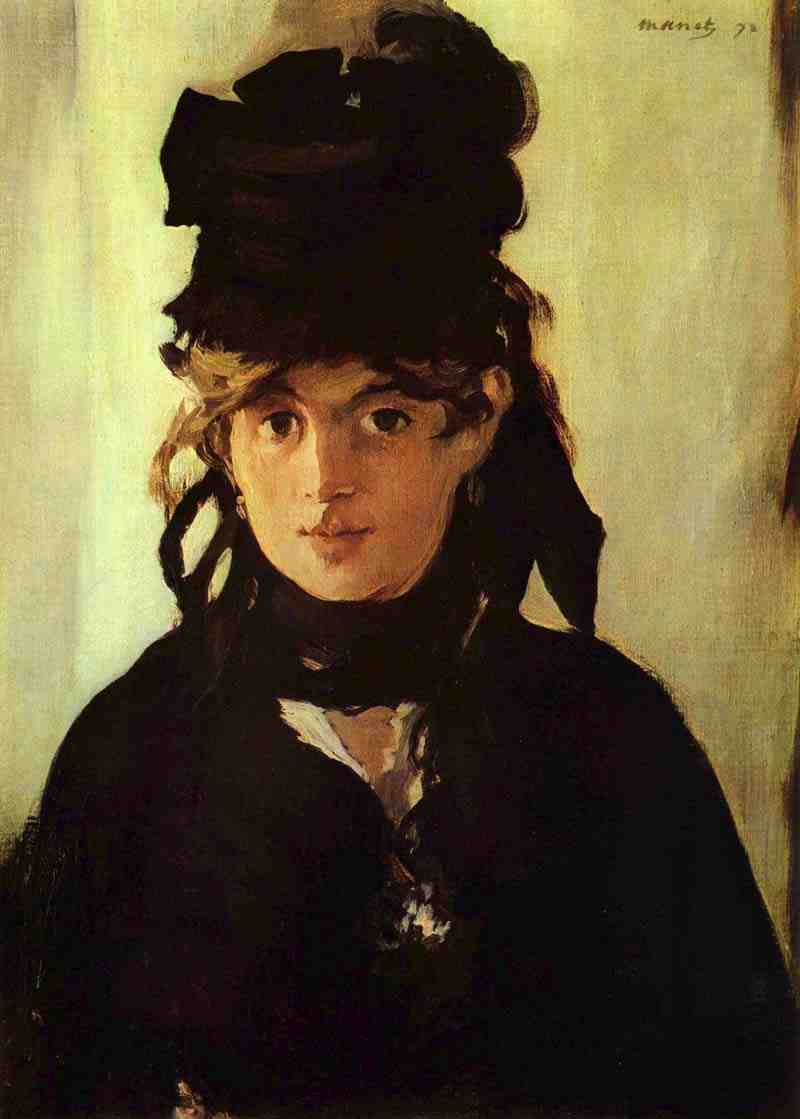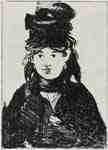
Portrait of Berthe Morisot with a Bouquet of Violets. Edouard Manet
1872, oil on canvas, 55 × 38 cm
Paris, Collection E. Rouart
---
Porträt der Berthe Morisot mit dem Veilchenstrauß. Edouard Manet
1872, Öl auf Leinwand, 55 × 38 cm
Paris, Sammlung E. Rouart
---
---
Fine Art Prints | Greeting Cards | Phone Cases | Lifestyle | Face Masks | Men's , Women' Apparel | Home Decor | jigsaw puzzles | Notebooks | Tapestries | ...
---
Berthe Morisot with a Bouquet of Violets (French: Berthe Morisot au bouquet de violettes) is an 1872 oil on canvas painting by Édouard Manet. It depicts fellow painter Berthe Morisot dressed in black mourning dress, with a barely visible bouquet of violets. The painting sometimes known as Portrait of Berthe Morisot, Berthe Morisot in a black hat or Young woman in a black hat. It is in the collection of the Musée d'Orsay in Paris.
Background
Manet became acquainted with Berthe Morisot in 1868. She was the grand-niece of Fragonard, and also a painter; Morisot and Manet influenced each other's work. He painted her portrait many times, including his earlier work The Balcony. She married Manet's brother Eugène in 1874.
Manet had remained in Paris during the Franco-Prussian War 1870-71, and served in the Garde Nationale to defend the city in the Siege of Paris. He was unable to paint while he was serving, and left Paris after the city surrendered at the end of January 1871. He returned to painting later in 1871, and returned to Paris after the defeat of the Paris Commune in May 1871.
This painting was one of four portraits of Morisot by Manet in 1872: the others show her with a pink shoe, with a fan, and veiled.
Description
The work measures 55 × 38 centimetres (22 × 15 in) and is signed "Manet 72" in the upper right corner. It is a study in shades of black. Unusually for Manet's portraits, which are typically have an even light, Morisot is lit from one side, so she is brightly illuminated on her right side and the left is in deep shadow. She wears black mourning dress and hat, with her face surrounded by black ribbons and scarves. Manet paints her with black eyes, although Morisot's eyes were actually green. The costume and dark eyes may allude to Manet's impression that she looked Spanish. Manet had earlier painted a similar portrait of his own mother in mourning, made in 1863, which shows his mother clad in black, on a dark background.
The violet flowers are hardly perceptible. Manet also painted violets also in his Woman with a Parrot of 1866.
The painting was followed by a similar etching and lithograph, and Manet made a similar painting of Morisot in mourning dress in 1874, after the death of her father, Edme Tiburce Morisot.
Reception
The work was quickly considered a masterpiece of Manet's work. It was praised by Paul Valéry in the catalogue of Manet's retrospective at the Orangerie in 1932, comparing the work to Vermeer: "I do not rank anything in Manet's work higher than a certain portrait of Berthe Morisot dated 1872".
Manet sold or gave the painting to collector and art critic Théodore Duret. Morisot herself acquired the painting in 1894, paying 5,100 francs in the sale of Duret's collection. After her death in 1895, it was kept by her daughter Julie Rouart until her own death in 1966, and then it was in the collection of her son Clément Rouart. It was acquired for the Musée d'Orsay in 1998, with funding from the Fonds du Patrimoine, the Meyer Foundation, the China Times Group and a sponsorship programme coordinated by the Japanese Nikkei newspaper.
Woman with a Parrot, 1866
The Balcony, 1868
Berthe Morisot in a Mourning Hat, 1874
References
Musee d'Orsay
Berthe Morisot With a Bouquet of Violets 1872, Google Art Project
Berthe Morisot au bouquet de violettes, Musée d'Orsay
Manet: Portraying Life – review, The Observer, 26 January 2013
Manet and the Family Romance, Nancy Locke, p. 147-149. 157-158, 168
Portrait of Madame Auguste Manet, 1863, Isabella Stewart Gardner Museum



